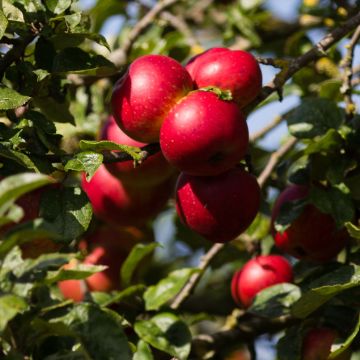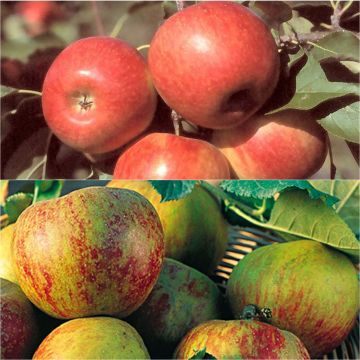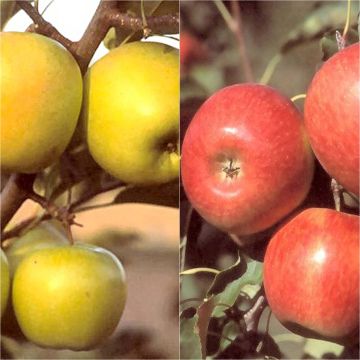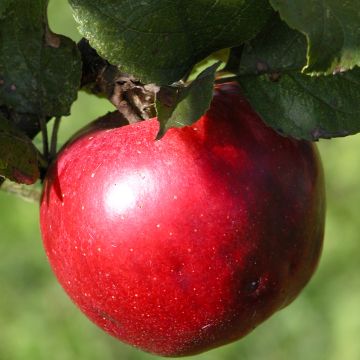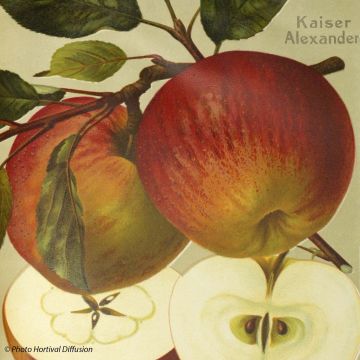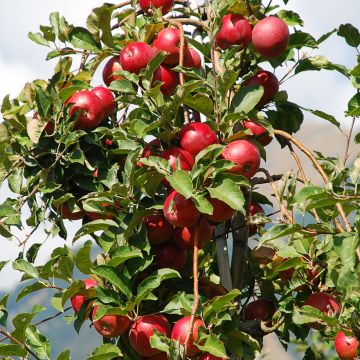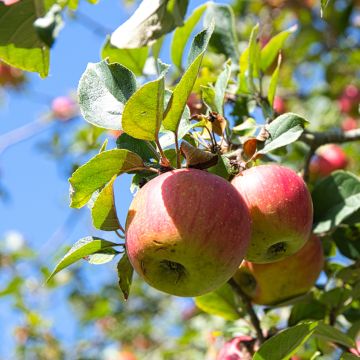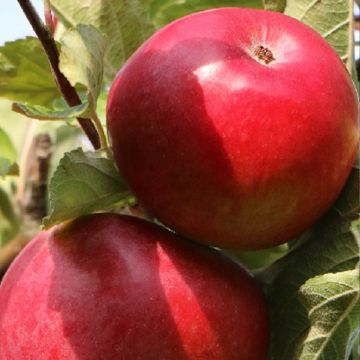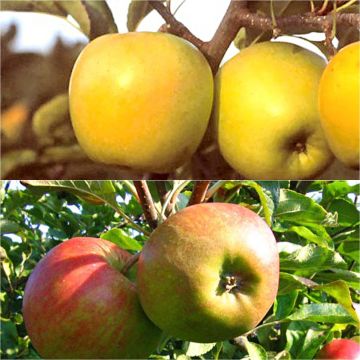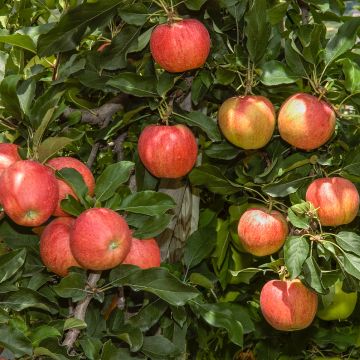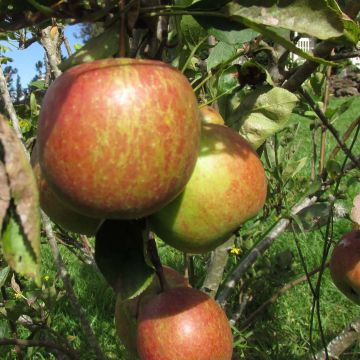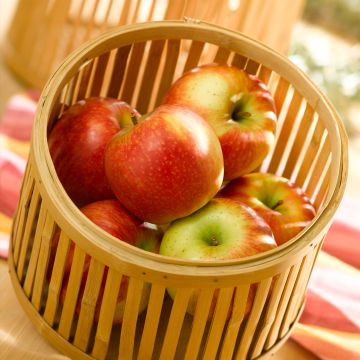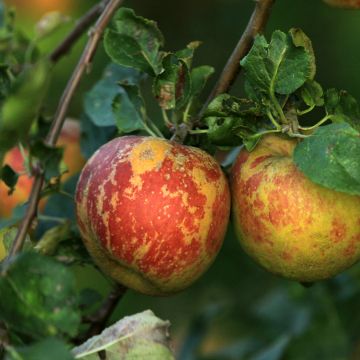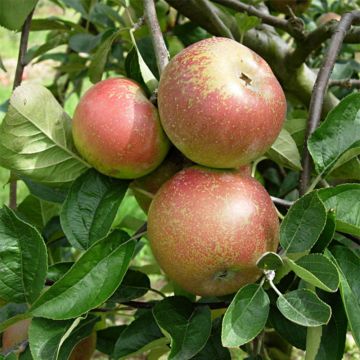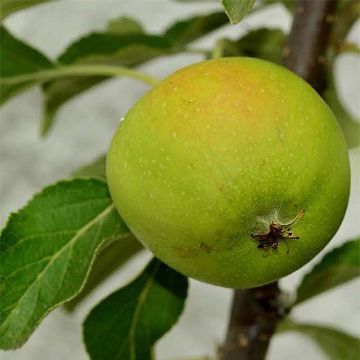Shipping country and language
Your country of residence may be:
Your country of residence is:
For a better user experience on our website, you can select:
Your shipping country:
Andorra
Austria
Belgium
Bulgaria
Canada
Chile
Croatia
Cyprus
Czechia
Denmark
Estonia
Finland
France
Germany
Greece
Hungary
Iceland
Ireland
Italy
Latvia
Lithuania
Luxembourg
Malta
Monaco
Netherlands
Poland
Portugal
Romania
Slovakia
Slovenia
Spain
Sweden
Switzerland
United Kingdom
We only deliver seed and bulb products to your country. If you add other products to your basket, they cannot be shipped.
Language:
French
German
Spanish
English
My Account
Hello
My wish lists
Plantfit
Log in / Register
Existing customer?
New customer?
Create an account to track your orders, access our customer service and, if you wish, make the most of our upcoming offers.
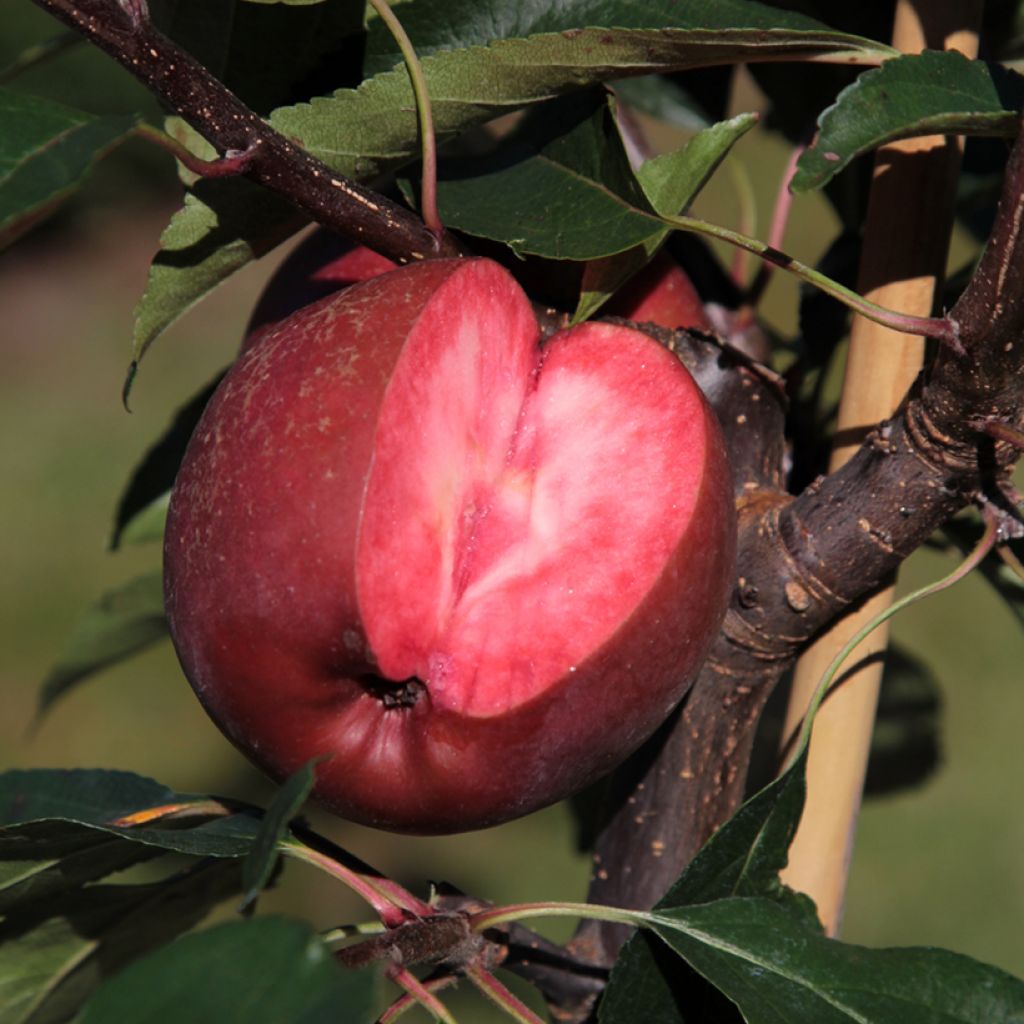

Pommier Red Merylinn - pomme sanguine
Apple Tree Red Merylinn - Malus domestica
Malus domestica Red Merylinn
Apple, Orchard apple, Table apple, Cultivated apple
Nice specimen. Planted after the frosts (March 2024), good recovery. No flowers yet but lots of leaves.
Marie , 02/11/2024
Why not try an alternative variety in stock?
View all →Order in the next for dispatch today!
Dispatch by letter from €3.90.
Delivery charge from €5.90 Oversize package delivery charge from €6.90.
More information
This item is not available in your country.
Schedule delivery date,
and select date in basket
This plant carries a 6 months recovery warranty
More information
We guarantee the quality of our plants for a full growing cycle, and will replace at our expense any plant that fails to recover under normal climatic and planting conditions.
Oversize package: home delivery by special carrier from €6.90 per order..
Express home delivery from €8.90.
Description
The Red Merylinn apple tree is a recent variety that produces a round, fairly regular, medium to large, blood-red apple with smooth, brilliant red skin. Its intense red flesh is crisp, moderately juicy, mildly sweet, and rather tart. From mid-September the fruits can be consumed immediately after harvest or can be stored until February if picked late and stored under optimal conditions. It is a slightly acidic apple raw, but it develops its flavours when cooked. Like all apples, it has good nutritional qualities with a high antioxidant content. It is a self-sterile variety that requires the presence of other apple varieties nearby to increase the number of fruits.
Malus domestica, also known as Malus communis or Malus pumila, is commonly called the Common or Domestic Apple tree. It belongs to the Rosaceae family. Present in Europe since antiquity, it is native to the forests of central Asia. It has excellent hardiness and is probably the most cultivated fruit tree in Northern Europe. There are about 20,000 varieties, including approximately 10,000 of American origin, 2,000 of English origin, and 2,000 of Chinese origin. The blood apple tree has its origins in Asia. Red Merylinn is a recent variety selected for the uniqueness and nutritional qualities of its red fruits.
The Red Merylinn apple is a moderately vigorous tree, with a quick fruiting period, moderately productive, and resistant to scab. At maturity, it can reach approximately 4 metres (13 feet) high and 3 metres (10 feet) wide. Its spreading habit is well suited to low or high standards and espalier forms. Its foliage consists of large, ovate leaves, greenish-brown on the upper surface and whitish-green on the underside, with deeply toothed edges. The white-pink blossom occurs around late April, which usually protects it from frost. The flowers are destroyed by frost at temperatures below -2 to -3°C. The Red Merylinn apple tree is a hardy plant that can tolerate temperatures around -20°C, making it suitable for cultivation in many regions. Its abundant and remarkably decorative blossom in spring is particularly attractive to bees and provides nectar. It is a variety that produces poor-quality pollen, making it weakly self-pollinating or pollinating. It produces apples with few or no viable seeds. It is said to be self-sterile, which is why the presence of apple trees flowering at the same time is necessary. Varieties such as Cox Orange, Golden Delicious, Reine des Reinettes, Royal Gala, or any other late-flowering variety are suitable for cross-pollination. Ornamental apple trees such as Perpetu Evereste and John Downie flower abundantly and can be excellent pollinators.
It is a slightly tart apple, best eaten cooked in compotes, pastries, or as a side dish for savoury dishes. It is also perfect for making highly coloured juice. It has a high anthocyanin content and natural pigments that give it its red colour and have recognised antioxidant and anti-inflammatory properties. Additionally, its high content of vitamins A, B, C, and E, minerals, and fibre make this apple a healthy choice. The fruits can be stored throughout the winter, even until February if harvested late. Store in a cool, clean place, protected from light at a temperature around 8 to 10°C or in a cold room, sealed off from outside air at a temperature of 1 to 3°C. The apple releases ethylene, a gas that promotes fruit ripening. To accelerate the ripening of other fruits or vegetables, place your apples next to them.
The apple tree is popular in the garden because of its fruit. Among a wide range of apple trees, it is easy to find a variety to suit.
Plant habit
Fruit
Flowering
Foliage
Botanical data
Malus
domestica
Red Merylinn
Rosaceae
Apple, Orchard apple, Table apple, Cultivated apple
Cultivar or hybrid
Other Apple trees
Planting and care
Choose a sunlit location for your Red Merylinn Apple Tree, the soil can be slightly chalky or acidic, but not excessively so. Dig a large planting hole at least 3 times the volume of the root ball. Add organic matter (topsoil, compost...) and a base fertiliser such as bonemeal. Do not bury the graft collar. Stake if necessary. For apple trees planted in isolation and in open ground, it may be a good idea to stake them by installing a bracing system: plant 3 stakes in a triangle 50 cm (20in) around the trunk, and connect them with pieces of wood. Protect the bark with a piece of rubber for example and attach the stakes to the trunk with metal wire. Water abundantly, even in winter, even if it rains. Fruit trees are ideally planted between October and March, outside the freezing period. Container-grown plants can be planted all year round except during periods of high heat or frost.
In winter you can lightly dig in a small handful of wood ash at the base of the tree, it is rich in potassium, which will improve fruiting. Apple trees can be subject to different diseases and pests. To limit risks, space the trees sufficiently, plant multi-species hedges, and install birdhouses or insect hotels to attract beneficial birds and insects. In summary: prioritise diversity. The main diseases of apple trees are scab (brown spots on leaves), brown rot (wilting of flowers and rotting of fruits on the tree), and powdery mildew (white powdery coating on leaves). For these three cases, preventive action is better by spraying a horsetail decoction, as a last resort and during severe attacks, you can apply a treatment based on Bordeaux mixture. As for pests, the codling moth (or fruit worm) is a small caterpillar which causes tunnels inside the fruit. To remedy this, it is better to act preventively by encouraging birds and bats through the installation of nesting boxes. In aphid infestation, spray a solution based on black soap.
During harvest in September, only keep the picked fruits. For good storage, place the apple with its stem downwards, on racks or in crates in a completely dark, dry, and cool, frost-free place.
Planting period
Intended location
Care
- , onOrder confirmed
Reply from on Promesse de fleurs
Haven't found what you were looking for?
Hardiness is the lowest winter temperature a plant can endure without suffering serious damage or even dying. However, hardiness is affected by location (a sheltered area, such as a patio), protection (winter cover) and soil type (hardiness is improved by well-drained soil).

Photo Sharing Terms & Conditions
In order to encourage gardeners to interact and share their experiences, Promesse de fleurs offers various media enabling content to be uploaded onto its Site - in particular via the ‘Photo sharing’ module.
The User agrees to refrain from:
- Posting any content that is illegal, prejudicial, insulting, racist, inciteful to hatred, revisionist, contrary to public decency, that infringes on privacy or on the privacy rights of third parties, in particular the publicity rights of persons and goods, intellectual property rights, or the right to privacy.
- Submitting content on behalf of a third party;
- Impersonate the identity of a third party and/or publish any personal information about a third party;
In general, the User undertakes to refrain from any unethical behaviour.
All Content (in particular text, comments, files, images, photos, videos, creative works, etc.), which may be subject to property or intellectual property rights, image or other private rights, shall remain the property of the User, subject to the limited rights granted by the terms of the licence granted by Promesse de fleurs as stated below. Users are at liberty to publish or not to publish such Content on the Site, notably via the ‘Photo Sharing’ facility, and accept that this Content shall be made public and freely accessible, notably on the Internet.
Users further acknowledge, undertake to have ,and guarantee that they hold all necessary rights and permissions to publish such material on the Site, in particular with regard to the legislation in force pertaining to any privacy, property, intellectual property, image, or contractual rights, or rights of any other nature. By publishing such Content on the Site, Users acknowledge accepting full liability as publishers of the Content within the meaning of the law, and grant Promesse de fleurs, free of charge, an inclusive, worldwide licence for the said Content for the entire duration of its publication, including all reproduction, representation, up/downloading, displaying, performing, transmission, and storage rights.
Users also grant permission for their name to be linked to the Content and accept that this link may not always be made available.
By engaging in posting material, Users consent to their Content becoming automatically accessible on the Internet, in particular on other sites and/or blogs and/or web pages of the Promesse de fleurs site, including in particular social pages and the Promesse de fleurs catalogue.
Users may secure the removal of entrusted content free of charge by issuing a simple request via our contact form.
The flowering period indicated on our website applies to countries and regions located in USDA zone 8 (France, the United Kingdom, Ireland, the Netherlands, etc.)
It will vary according to where you live:
- In zones 9 to 10 (Italy, Spain, Greece, etc.), flowering will occur about 2 to 4 weeks earlier.
- In zones 6 to 7 (Germany, Poland, Slovenia, and lower mountainous regions), flowering will be delayed by 2 to 3 weeks.
- In zone 5 (Central Europe, Scandinavia), blooming will be delayed by 3 to 5 weeks.
In temperate climates, pruning of spring-flowering shrubs (forsythia, spireas, etc.) should be done just after flowering.
Pruning of summer-flowering shrubs (Indian Lilac, Perovskia, etc.) can be done in winter or spring.
In cold regions as well as with frost-sensitive plants, avoid pruning too early when severe frosts may still occur.
The planting period indicated on our website applies to countries and regions located in USDA zone 8 (France, United Kingdom, Ireland, Netherlands).
It will vary according to where you live:
- In Mediterranean zones (Marseille, Madrid, Milan, etc.), autumn and winter are the best planting periods.
- In continental zones (Strasbourg, Munich, Vienna, etc.), delay planting by 2 to 3 weeks in spring and bring it forward by 2 to 4 weeks in autumn.
- In mountainous regions (the Alps, Pyrenees, Carpathians, etc.), it is best to plant in late spring (May-June) or late summer (August-September).
The harvesting period indicated on our website applies to countries and regions in USDA zone 8 (France, England, Ireland, the Netherlands).
In colder areas (Scandinavia, Poland, Austria...) fruit and vegetable harvests are likely to be delayed by 3-4 weeks.
In warmer areas (Italy, Spain, Greece, etc.), harvesting will probably take place earlier, depending on weather conditions.
The sowing periods indicated on our website apply to countries and regions within USDA Zone 8 (France, UK, Ireland, Netherlands).
In colder areas (Scandinavia, Poland, Austria...), delay any outdoor sowing by 3-4 weeks, or sow under glass.
In warmer climes (Italy, Spain, Greece, etc.), bring outdoor sowing forward by a few weeks.
